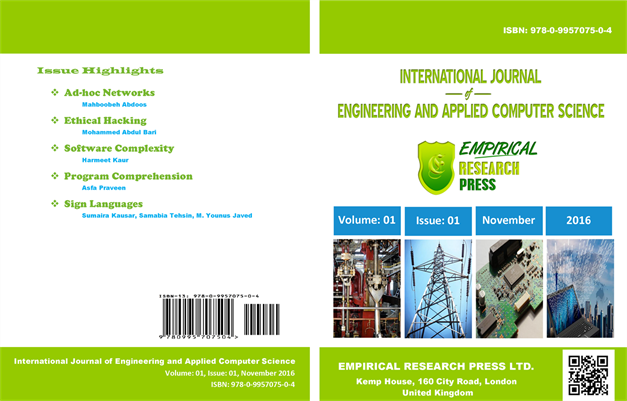



Volume: 01, Issue: 01, November 2016

Content

Mahboobeh Abdoos
h-index
6

THOMPSON
REUTERS
REUTERS
RESEARCH
GATE
GATE
ACADEMIA
EDU
EDU
INTERNET
ARCHIVE
ARCHIVE
GOOGLE
SCHOLAR
SCHOLAR
SCRIBD
i10-index
4
M. Abdoos, “The Proposed Cluster and Position Based Fault Tolerant Multicast Protocol in Ad Hoc Networks,” International Journal of Engineering and Applied Computer Science, vol. 01, no. 01, pp. 01–06, Nov. 2016. https://doi.org/10.24032/ijeacs/0101/01
Impact Factor
2.35
Abstract—A location service gives the requested location information to the nodes in the ad hoc networks. It is supposed that there are different clusters in the different levels. Every cluster has a cluster head. The clusters can be logical or physical. The higher level cluster heads have the information of the tables of lower level cluster heads. The information of tables of a cluster head is updated periodically by its lower level cluster heads. The combination of the cluster and position based routing can be used. In this paper the cluster and position based location service is represented, that every node can find the location of its destination node via the location service. Some nodes are selected as the mirror nodes of a cluster head which can act as the cluster head after the failing of cluster head. These nodes have the replicated information of a cluster head. Here a multicast protocol is proposed that a source node can get the location information of the destination nodes via the proposed location service and puts this information into the header of packets and sends them toward the destination nodes. The simulation results show that the proposed Cluster and Position based Multicast protocol (CPMB) has more packets delivery ratio and packets transfer ratio than the Multicast Ad hoc On-Demand Distance Vector multicast protocol (MAODV).

Mohammed Abdul Bari, Shahanawaj Ahamad

THOMPSON
REUTERS
REUTERS
RESEARCH
GATE
GATE
ACADEMIA
EDU
EDU
INTERNET
ARCHIVE
ARCHIVE
GOOGLE
SCHOLAR
SCHOLAR
SCRIBD
M. A. Bari and S. Ahamad, “Study of Ethical Hacking and Management of Associated Risks,” International Journal of Engineering and Applied Computer Science, vol. 01, no. 01, pp. 07–11, Nov. 2016. https://doi.org/10.24032/ijeacs/0101/02
Abstract—Hacking has become an extensive trouble with the beginning of the digital age, almost worldwide access to the internet and other digital media. It is significant for individuals, corporations, and the government to guard them from being susceptible to such attacks. The purpose of this paper is to provide information about ethical hacking; their skill to share advanced security knowledge and capabilities with organization and pointing out their vulnerabilities.

Harmeet Kaur, Gurvinder N. Verma

THOMPSON
REUTERS
REUTERS
RESEARCH
GATE
GATE
ACADEMIA
EDU
EDU
INTERNET
ARCHIVE
ARCHIVE
GOOGLE
SCHOLAR
SCHOLAR
SCRIBD
H. Kaur and G. N. Verma, “Software Complexity Measurement: A Critical Review,” International Journal of Engineering and Applied Computer Science, vol. 01, no. 01, pp. 12–16, Nov. 2016. https://doi.org/10.24032/ijeacs/0101/03
Abstract—It is considerably recognized that in software engineering, the utilization of metrics at the initial stages of the object oriented software can encourage designers to bring about a noticeable improvement decisions. In this paper, a literature review and classification scheme for software complexity measurement researches is presented. The study shows that an expanding volume of complexity measurement has been conducted in diverse range of areas. As software complexity is an important factor that ought to be recognized at different levels of software development and it requires in profundity study with comprehension. Examinations of the chosen scrutinizes are completed and holes in the exploration are recognized. Analyses of the selected researches are completed and crevices in the research are identified. A complete record of references is explored. This review is planned to furnish driving force in exploration and help simulate further interest.

Asfa Praveen

THOMPSON
REUTERS
REUTERS
RESEARCH
GATE
GATE
ACADEMIA
EDU
EDU
INTERNET
ARCHIVE
ARCHIVE
GOOGLE
SCHOLAR
SCHOLAR
SCRIBD
A. Praveen, “Program Comprehension and Analysis,” International Journal of Engineering and Applied Computer Science, vol. 01, no. 01, pp. 17–21, Nov. 2016. https://doi.org/10.24032/ijeacs/0101/04
Abstract—Due to continuous change in business requirements and to implement proactive, adaptive maintenance procedures in application program; it is required to evolve application program time to time. Program comprehension is a process of program understanding and reverse engineering, which supports the analyst to easily undertake the program for further reengineering. This paper highlights the program elements, components, its analytical solutions for understanding, comprehensions and extension.

Sumaira Kausar, Samabia Tehsin, M. Younus Javed

THOMPSON
REUTERS
REUTERS
RESEARCH
GATE
GATE
ACADEMIA
EDU
EDU
INTERNET
ARCHIVE
ARCHIVE
GOOGLE
SCHOLAR
SCHOLAR
SCRIBD
S. Kausar, S. Tehsin, and M. Y. Javed, “Fuzzy Model for Parameterized Sign Language,” International Journal of Engineering and Applied Computer Science, vol. 01, no. 01, pp. 22–30, Nov. 2016. https://doi.org/10.24032/ijeacs/0101/05
Abstract—Sign languages use visual pattern to communicate rather than acoustic patterns that are communication mode in verbal communication. Sign languages being the most structured form of gestures can be considered as the benchmark for systems of gesture recognition. SLR has got its applicability in the areas of appliances control, robot control, interactive learning, industrial machine control, virtual reality, games, simulations etc. apart from its significance for hearing impaired community. The paper aims to present a systematic, robust, reliable, and consistent system for static Pakistani Sign Language (PSL) recognition. The paper is based on empirical evaluation of different classification techniques for SLR. This pragmatic approach leads to a Fuzzy Model (FM) that has shown very high accuracy rate for PSL recognition. Sign languages have inherent uncertainty, so SLR systems demand a classification method that give due consideration to this aspect of uncertainty. This is the reason for selecting fuzzy inference for the proposed SLR system and experimental analysis has proven its suitability for SLR. The meticulous statistical analysis performed for proposed PSL-FM has shown very promising results.










